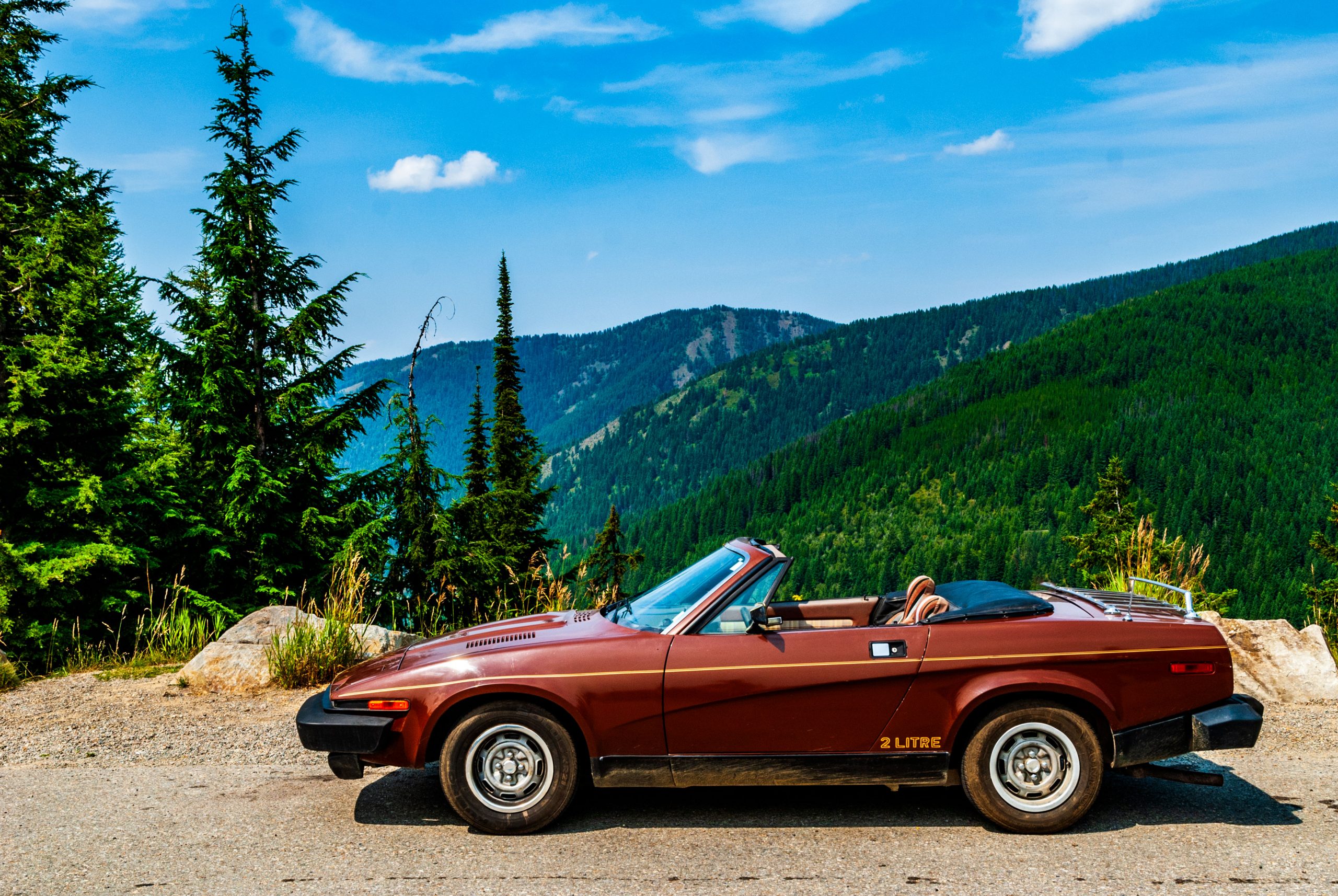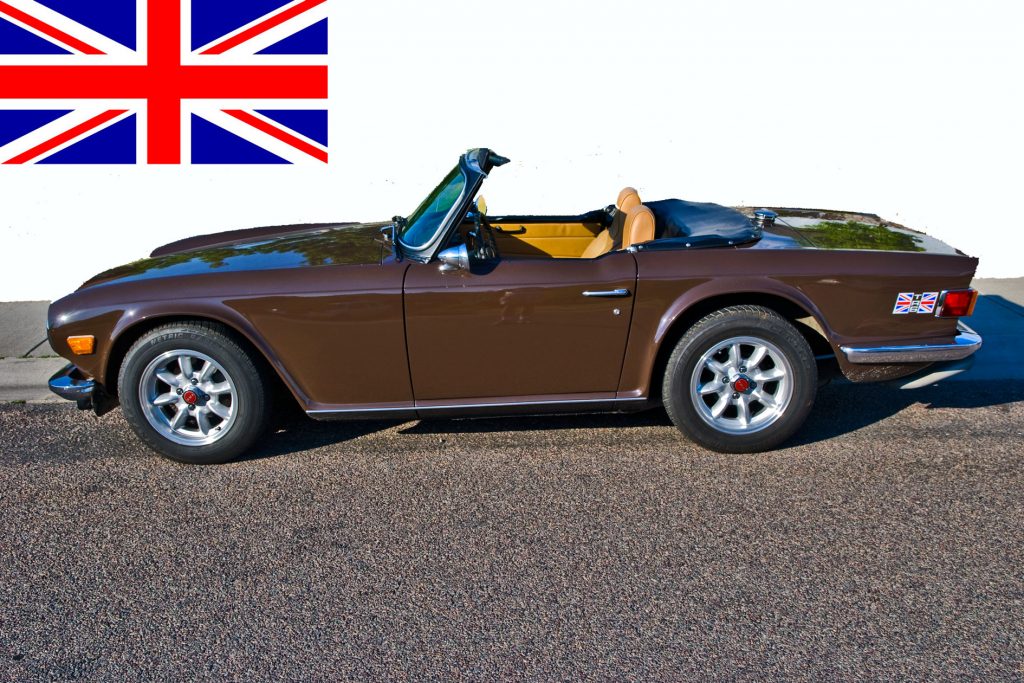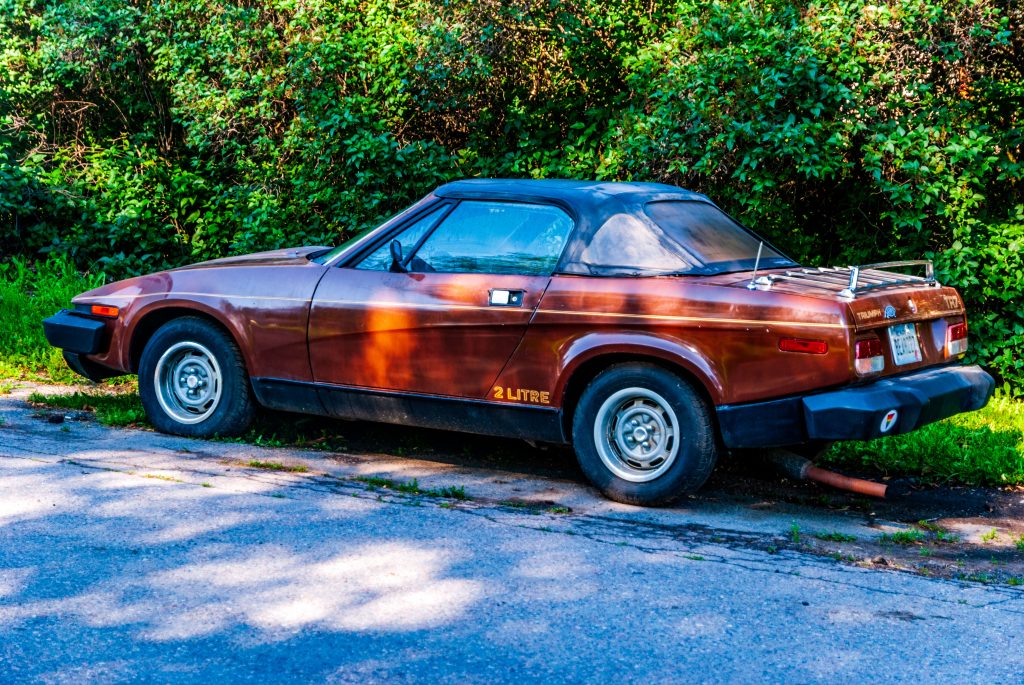My Triumph TR7 Saga

In 1990, my partner Gary and I were driving north on Division Street in Spokane, Washington. We had other reasons for being in Spokane, but Gary was looking for a car. Spokane is the largest “big” city to us. Gary spotted something parked in a lot across the street and asked “What is that?” I replied, “It’s a Triumph TR7. You don’t want it.” Famous last words. It’s now twenty years later and I still have that Triumph. And thus begins my Triumph TR7 Saga.
I bought the car, needless to say, and Gary drove it home. He had great fun driving across the two mountain passes with the top down. I wasn’t sure the car would even make it home (210 miles with, as noted, two mountain passes to cross). It did and Gary was exhilarated. That exhilaration lasted till he took the car for another drive, and called home saying “What do I do? The car has stalled and there’s white smoke pouring out from the hood.” At that point he had driven 134 miles, roughly half of that distance on Interstate 90. He had 27 miles to go to get home.
I offered to come to Arlee and pick him up, but before I could leave, he had the car running and drove on home himself. He started looking for a new car immediately, and eventually found himself a bright red Mustang convertible which he had for the rest of his life. I refused to sell the Triumph, and as I said above, I still have it today.
A Brief History of Triumph Sports Cars
Triumph had its start in 1885 as an importer of bicycles from Germany. Bicycles became Triumph motorcycles in 1902 and in 1923, the company made their first motorcar, the Triumph 10/20. The first real sports cars, as we think of them, came out in 1933 in the form of the Triumph Gloria Southern Cross.
Richard Lentinello writing in the July 2019 issue of Hemmings Classic Car describes the Southern Cross as “the Gloria’s ‘grand touring’ sports car.” He goes on to say “With the entire Gloria line created to push Triumph upmarket, the Southern Cross was blessed with handsome good looks thanks to its well-proportioned two-seat body. It offered several distinctive features such as an upright chrome mesh grille, an unusually tall engine compartment with double row of louvers on each side, cut-down doors, and tall 17-inch wheels for a rugged appeal, along with its signature twin spares in the rear. With so many sporting cars of the day being puny and somewhat frail looking, the Southern Cross had a very robust, muscular appearance about it.”
Triumph built the Southern Cross until 1938 and the company went into receivership in 1939. World War II should have put the company out of business entirely. German bombing destroyed the Triumph factory in 1940. After the War, Standard Motor Company bought the remains of Triumph and began building cars with both the Standard and the Triumph names.
The TRs
Standard-Triumph produced a concept car called the Triumph 20/TS which became known as the TR1. That led to the production of the Triumph TR2 which sold from 1953 through 1955. Between 1955 and 1962, Triumph built the TR3 (in three variants), and brought out the TR4 in 1961. The TR4A came in 1965 and the TR5 in 1967. It is worth noting that in North America, Triumph sold the TR5 as the TR250.
The Triumph TR6
Introduced in 1968, the Triumph TR6 is arguably the car most folk today think of when they hear the name Triumph. British Leyland produced 91,850 of them between 1968 and 1976, and exported over 90%. Less than 9,000 sold in the U.K. From the TR2 through the TR6 discerning observers can see a continuity of line as the cars developed and as modern styles changed. The main distinction between the TR6 and its predecessors is the squared off tail and front end. From the side, the TR6 looks very much like the TR250 and even the TR4.
Other Triumph Sports Cars
My Triumph TR7 Saga didn’t begin with Gary’s car. Way back in 1980, I saw a car for sale a couple of blocks from home. It was red, had two seats, and looked very fast. I bought that 1976 Triumph Spitfire and, yes, still have it forty years later. Maintenance and repair of that Spitfire has cost me three times the purchase price, and the car now needs a complete ground-up restoration. But it is a member of the family, what can I say.
Triumph built the Spitfire from 1962 through 1980. Some 314,000 Spitfires came off the assembly line in five different versions over the years. In addition, a fast-backed hard top, the GT6 sold between 1966 and 1973. That’s more likely when my Triumph TR7 saga began.
In 1972, I was looking for a car to replace my 1964 Comet Caliente. I found a GT6 in Berkeley, and was all set to buy it. I made the mistake of taking Poppa for a test drive. Driving around the Berkeley Hills, Poppa put his foot down–and not on the accelerator. “You will NOT buy this car,” he told me. And just like any kid who hears the word “No,” I’ve wanted a GT6 ever since. I don’t know. Maybe if Poppa had let me buy the GT6, I would have learned my lesson and that would be the end of my love affair with Triumphs.
The Stag
I’ve never had one, but I love the Triumph Stag. I’ve seen too few of them to even photograph one. Built between 1971 and 1977, the Stag had a 3 liter V-8 engine. Ostensibly built to compete with Mercedes and Jaguar, the Stag had so many engine problems that Time magazine named it one of the 50 worst cars ever built. I don’t care. I want one!
The TR7 and TR8
As the TR6 neared the end of its production run, British Leyland introduced the TR7. Sold only as a coupe, most TR7s headed overseas. In fact, the car sold in the United States for almost a year and a half before it ever reached British car buyers. US regulations made it near impossible to build convertibles, so the drop head coupé did not see production until 1979, again being sold in the U.S. long before sales started in the U.K.
Powered by a 2-liter 4-cylinder engine, the car grabbed its share of enthusiasts, and surpassed the TR6 sales by 20,000. In 1977, British Leyland popped a V-8 engine under the bonnet (as the Brits call hoods) because they felt Americans wanted a more powerful car. Almost all TR8s (as the 8-cylinder version was called) came to the U.S. British Leyland products suffered from poor quality, and the TR8 did not fare well.
My TR7
All of which brings us back to the russet brown car parked in my driveway, and my Triumph TR7 saga. As near as I can tell, based just on photographs I’ve taken, I have not driven my TR7 since 2013. That’s seven years the car has been sitting, waiting for me. I have no idea what condition the car’s mechanical parts are in. All need checking very carefully. I do know that the top needs replacement. I’ve had seat covers over the original upholstery as long as I’ve owned the car, but in truth, I should replace the seats. They can wait as the top alone, assuming I do all the labor, will cost $450. The seats are an addition $360, unless I opt for leather, in which case the seat cost will be $1000. It’s not cheap restoring a classic car.
And I have trouble thinking of my TR7 as a classic. Then I remember that it was built in 1980–forty years ago. Surely that alone makes it a classic. Emily Delbridge, writing for The Balance, says that the simplest definition of “classic” is “old.” My car isn’t “old.” 1980 wasn’t that long ago, was it? The TR7 isn’t even the oldest car I own. Delbridge notes that if I want “Vintage” plates, Montana law requires the car to be older than 30 years. (New York only requires a 25 year wait.)
There are other considerations as well. Will I use it as a daily driver? Will I take it to car shows and cruises but not to the grocery store? I guess for me, it all depends on how much work I need to put into getting it back on the road. To that end, I’ve added as my guest site of the day, a post from Hagerty.
Guest Site of the Day
Hagerty leads in insuring classic, vintage, antique automobiles. The company also posts articles regularly on the hobby of collecting cars. On April 27th, 2020, Rob Siegel wrote “11 checks to make before your first springtime drive.” I’ve linked to that article as today’s Guest Site, and believe me, I’ll be going through the list as part of my Triumph TR7 saga.
Video of the Day
Motorcar History has provided a video on the History of the TR7. Featuring a bright lime green model, the video talks not just about the history of the model itself, but also about the trials and tribulations the current owner has faced in restoring his TR7. Note that the car in question is a UK model, so the steering wheel appears on the wrong side.
Recipe of the Day
I can count on Kevin ordering shrimp fried rice (or more commonly combination fried rice) whenever we visit an Asian restaurant. When my cousin Angie posted this recipe on Facebook, I immediately came to attention. If I can make Kevin’s favorite Chinese dish at home (and of course I can), then why wouldn’t I. So, here it is, Better than Take-out Fried Rice. Enjoy!
And That’s It for Today!
Thanks for joining me on the beginning of my Triumph TR7 Saga. As I work on getting the car back on the road, I’ll be sure to keep you informed about what my own trials and tribulations are. And there will be photos. Count on it.
TTFN
![]()



You made some really good points there. I looked on the web for
more information about the issue and found
most people will go along with your views on this web site.
Thank you. –Bryan